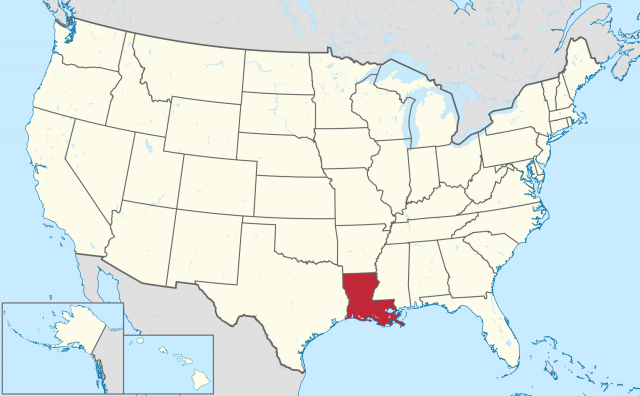Louisiana
SITUATED AT THE MOUTH of the MISSISSIPPI RIVER on the coast of the Gulf of Mexico, Louisiana and its people have long been influenced by the intersection of these two major water features. The physical geography of Louisiana can be examined in terms of its five natural regions: the Coastal Marsh; the Mississippi Flood Plain; the Red River Valley; the Terraces; and the Hills. Each has played an important role in the history of the state. The southernmost of these regions is the Coastal Marsh, which serves as a transitional area between land and sea. Characterized by fresh and saltmarsh vegetation as well as peat soils, this natural region serves to provide rich fishing grounds that support the second-largest seafood industry in the UNITED STATES today.

Heading northward away from the coastal areas, rivers dominate not only the physical landscape but also the economic geography of Louisiana. The Red and Mississippi rivers are distinguished as separate natural regions because of soil and drainage differences, however, they are inherently interconnected and provide an extensive waterway transportation system upon which the Louisiana economy has been built. Combined with five deepwater ports and proximity of the Gulf of Mexico, the river system of Louisiana serves as natural gateway for the exchange of not only goods produced in the state but much of the U.S. midwest as well. While the petrochemical and mineral resource industries are most often associated with the importance of waterway transportation today, the fertile flood plains of the Mississippi River have long been a source of agricultural wealth for the state by producing large quantities of cotton, soybeans, and rice. Rising above the river floodplains into the Terraces and Hills, the forest industry prevails because of the availability over 13 million acres (5.2 million hectares) of hardwood and pine forests.
Natural resources alone do not provide all of the state's economic foundations. Louisiana has also developed a strong tourism industry premised upon its unique cultural heritage. The idea of “cultural gumbo” is often used to describe the people of Louisiana, as they are like the famous gumbo dish created out of many separate ingredients that blend together to create a delightful experience. Throughout its history, the territory that now encompasses Louisiana has been governed under 10 different flags. Although originally claimed by Hernando de Soto for SPAIN in the early 1540s, Louisiana remained largely ignored by Europeans until Robert de La Salle claimed the territory for FRANCE in 1682. The first permanent settlement was finally established in 1714.
Despite the strong French and Spanish presence in the territory, other Europeans, including Germans farmers, began to arrive, each adding their own influences to the Louisiana culture and landscape. With a military victory over France and Spain in 1763, Great Britain also laid claim to the portion of Louisiana east of the Mississippi River basin. While European nations struggled with each other for control of Louisiana, other cultural groups continued to arrive. The rich soils of the river lands fostered the growth of a plantation economy that depended upon the importation of African and Afro-Caribbean slaves who contributed to the formation of the culture in south Louisiana. This area was also settled by Creoles, the French-speaking Acadians who fled British control of Nova Scotia and made their way into south-central Louisiana and are today recognized by the name Cajuns.
Even after the LOUISIANA PURCHASE in 1803 and its incorporation into the United States in 1812, portions of Louisiana would be governed under a foreign flag. In 1810, a controversy arose between the United States and Spain over the control of portions of eastern Louisiana, resulting in the declaration of the shortlived independent Republic of West Florida. Finally, in 1861, Louisiana seceded from the Union and after only a six-week period as an independent republic joined the Confederacy and its efforts in the Civil War. After the conclusion of the war, Louisiana was readmitted to the Union in 1868.
Despite the passage of over 130 years of continual U.S. control, the people of Louisiana have seldom forgotten their past and continue to draw upon it today to create a diverse cultural experience blended from a unique history and environment.